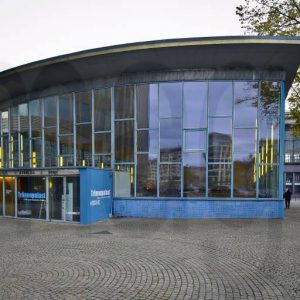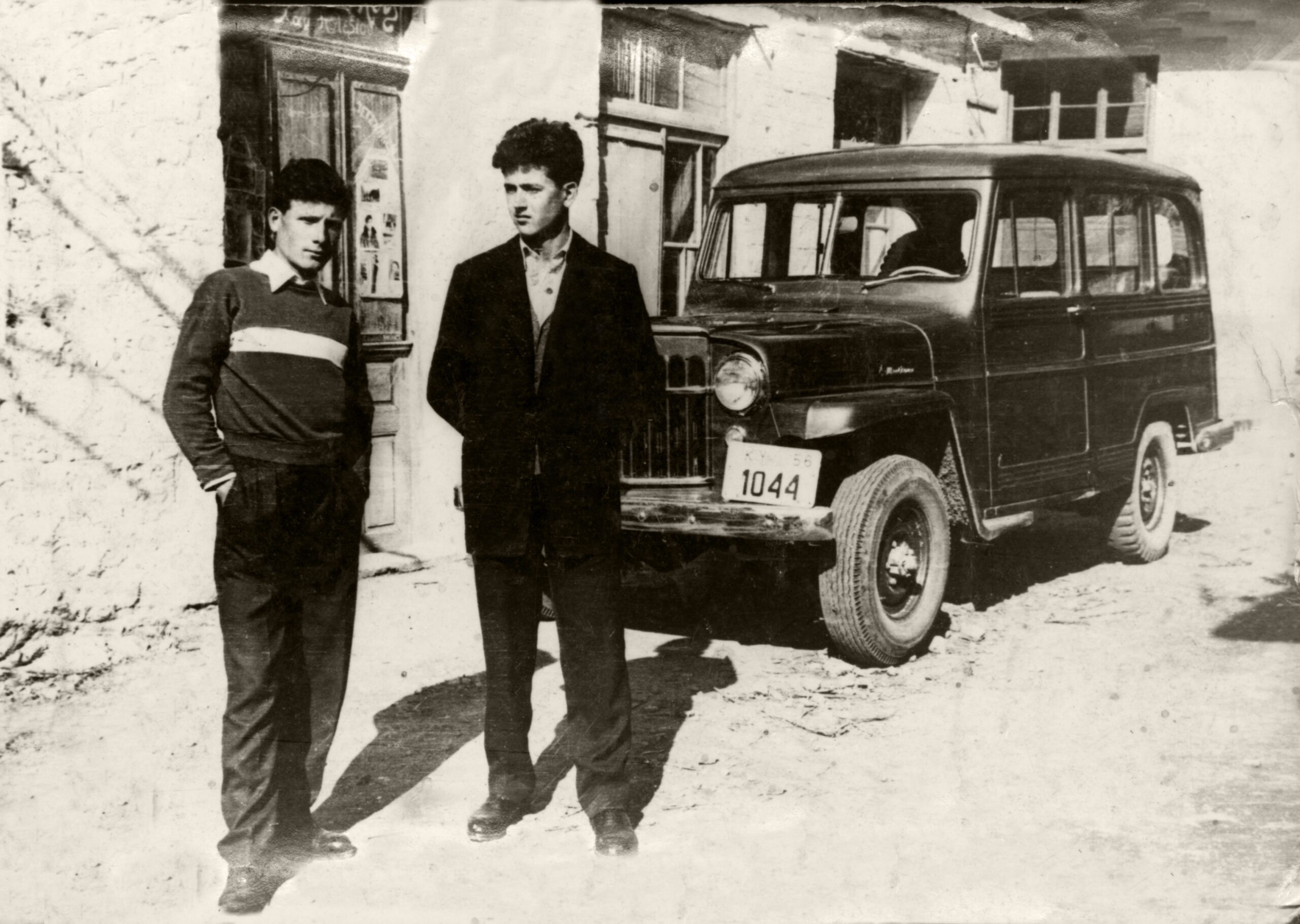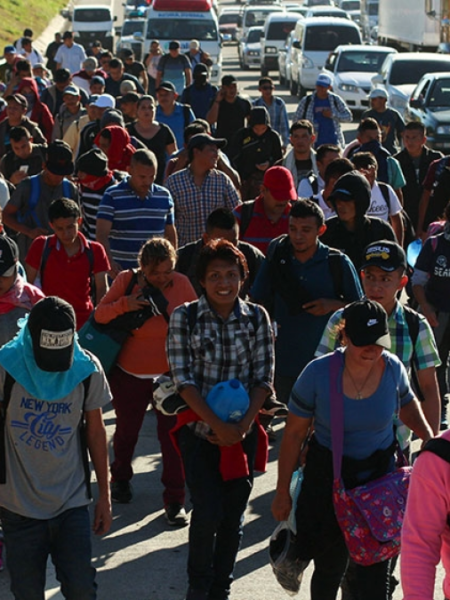In the historical revision of the history of the German Democratic Republic (GDR) and its former refugees, illegal refugees – “Republikflüchtlinge”, are the main focus of the historical reappraisal.1 However, the legal emigration movement of the “Übersiedler” (resettlers) accounted for half a million people who left the country between 1961 and 1989. In addition to those, who successfully relocated, many more withdrawn applications for permanent departure remain uncounted. Thus, the emigration movement made up a large group of those, who left the GDR. On the annual German National Day of Reunification, the 3rd of October, we remember Germanys’ division and reunification. It reminds us of a country that once lived divided into two bipolar systems for almost 30 years. To what extent was the “emigration movement” politically persecuted in the GDR? How much of this division and its consequences did Germany reappraise so far? This paper deals with the topic of border crossing in a global historical sense and aims to contribute to the historical culture of remembrance by representing experiences of socio-political repression in response to applications for permanent departure in the GDR. The paper presents research results of an independently conducted project on oral history, which is part of the Global History Dialogues Project course at Princeton University. The paper introduces the concept of “open isolation”, which serves as a more precise record of the socio-political repression experiences of people who applied for permanent leave from the GDR.
Methodology
This work focuses on the overarching theme of the History Dialogues Project: border-crossing. In the case of the German Democratic Republic, this concerns the experiences of socio-political repression associated with leaving the GDR permanently. Consequently, this paper aims at describing this phenomenon, more precisely by using reports from contemporary witnesses, who experienced socio-political repression as a result of applying for emigration to a non-socialist country. Before introducing excerpts of interviews conducted by the author, the historical context and measures of repression are reviewed. This paper refrained from including experiences of flight and imprisonment, as this would go beyond the scope of this work.
Historical context
In the following section, the socio-political tensions within the German Democratic Republic (GDR) are placed in their historical context as an attempt to approach the phenomenon of socio-political repression in the GDR from a historical perspective. The focus is on the contradiction between the regime of the Socialist Unity Party of Germany (SED) and the population. This approach serves as an introduction to the topic and provides an analytical framework for the subsequent presentation of the research results.
After Germany capitulated in World War II in May 1945, Germany lost its state sovereignty and was divided into four occupation zones, under the four allied victorious powers: France, the Soviet Union, Great Britain, and the USA. At the Potsdam Conference, which took place from 17 June to 2 August 1945, the occupying powers agreed to decentralize, denazify, demilitarize and democratize the country. However, in the ensuing policy agreements, it quickly became apparent that the Potsdam Agreement had been interpreted differently and was being enforced in differing ways.2 While the Western powers were very similar in their policies, the Soviet occupation zone stood out through a rigorous transformation of political and social structures along Soviet lines. With the rising tensions of the systemic confrontation between the victorious powers, a lasting bipolarity, and finally, the division of Germany during the Cold War became apparent. With the constitution of the GDR in 1949, the establishment of the GDR was complete. The increasing tension between the two opposing systems did not only lead to confrontation but also to a competition of two political systems.3The aspect of competition began to deepen the conflict between West and East and finally gave the economically weak GDR reason to close its borders on April 13th in 1961 to prevent further emigration of its citizens to non-socialist foreign countries.
The Expansion of SED-Ideology
Whereas ideological terror within the GDR was more openly exposed at the beginning during the Ulbricht era, the Honecker era was marked by a move away from open terror for foreign policy purposes. However, that did not mark the end of such practices. Pingel-Schliemann describes this as “subtle totalitarianism” and thus categorizes the GDR as a totalitarian state. 4 The historian and political scientist Gerhard A. Ritter described the socio-political tensions within the GDR as follows: “The question remains as to the scope of the dictatorship, the tension between the SED leadership’s total claim to control and the society’s own dynamics or the ‘own-will’ of its citizens, who tried to maintain a certain autonomy from the claims to power of party and state.” 5 The GDR state concept attempted to unite the main characteristics of real socialism and principles of democratic centralism, but soon the GDR developed towards an opposing direction of authoritarian centralism and a dictatorial one-party state. Consequently, the SED party governed the GDR in a way, that can be classified as dictatorial. The dictatorship gradually extended its influence on the population through ideological educational measures in school and reprisals against acts that were perceived to be harmful to state safety.
In her work on GDR cultural policy, Peschke provides insight into the ideological and political leadership mechanisms. The hierarchical control of the GDR’s system of rule, the model of democratic centralism, practically determined all interactions at the political and social level of the state. Thus, the cultural policy served as a political instrument of power to instrumentalize and control social areas at the macro level.6The SED’s claim to power and control provided for close networking of state institutions, in which the SED assumed a dominant position. This left little room for independent acting of subordinate authorities. Therefore, there was virtually no separation of powers and the SED thus secured control of the executive, legislative and judicial branches. The populations dissatisfaction manifested itself and showed in mass emigration from the GDR. Mass emigration was stopped by building the Berlin Wall in 1961.7
Contradictions of law
Between 1961 and 1975 there was no legal basis for the emigration policy. 8 After the first Helsinki Conference on Security and Cooperation in Europe in 1975, the focus of mass emigration shifted from illegal escape of the German Democratic Republic to a mass movement of permanent emigration seekers, regulated by an application process. The eastern German GDR had joined an international agreement to recognize the right to freedom of movement. Nevertheless, the filing for an application for permanent departure was still declared an illegal act within the GDR. 9 A key factor in the line of state argumentation regarding the rejection and political persecution of applicants for departure was the lack of a legal basis within the GDR. 10 The number of applications for permanent emigration increased continuously. Although the application for emigration did not exist officially, word spread in social circles. With signing off the final document of 1980 in a CSCE follow-up meeting in Madrid, it was legally established, that applications for family reunification and marriage would have to be decided as soon as possible. It was also decided that:
- applications would not entail any negative consequences for applicants,
- the authorities would have to provide the application form and inform the public about the procedure,
- repeated applications must be accepted 11
On the contrary to the legally binding accession of the GDR, the unilateral party deliberately used a non-transparency strategy to isolate applicants from one another.12 Further, it resorted to an unpredictable approach by the authorities, featuring state arbitrariness. This was part of the “decomposition and attrition strategy” towards applicants for departure. Hanisch notes: “Thus, the Madrid final document effectively created the right to apply for family reunification – which in most cases meant an application for departure – if necessary several times in succession”.13 The SED leadership found itself increasingly under pressure in foreign as well as in domestic politics. Besides, the aim of maintaining recognition in foreign policy, the one-party state still claimed complete internal control at the same time. The unity party opted for a “push-back strategy” towards the emigration movement and made the prevention of “criminal offenses” its priority. The aftermath of condemnation and the measures deployed were devastating. 14
Strategies of repression against the legal emigration movement

From the previous section, it became evident that due to the ideological claim to leadership of the Socialist Unity Party of Germany, any thinking and acting that deviated from the clear path of GDR political education, was considered a criminal offense. The will to leave the country was consequently categorized as “anti-systemic behavior”. A survey and data collection in 1990 on motives for leaving the GDR revealed various reasons. These included, above all, family reunification, marriage, restrictions on basic and human rights, restriction of personal development, restrictions concerning the freedom of movement, economic flight, and flight due to a shortfall of supplies, as well as the flight from political pressure. Evidently, reasons for wanting to leave the country were partly politically motivated and partly due to private reasons.15 In the following, the repressive measures taken against those willing to leave the socialist country will be presented in two steps.
Fundamental discrimination
If someone decided to apply to leave the country, despite the obvious threat of discrimination and the deliberate withholding of the application form by the authorities, one would face fundamental restrictions of freedom of travel and suffer economic consequences as well as contact restrictions. After applying for departure, those affected were usually issued with a replacement identity card, a so-called PM 12 identity card. This was a means of surveillance and severely restricted a person’s freedom of travel, even within the GDR.16 Also, when resettling to a non-socialist country, a transfer of property and wealth was required. Therefore, the instrumentalization of one’s own property against applicants meant that they were obliged to cede the majority of their assets and private property to the state. Moreover, after leaving the country, people were barred from re-entering the GDR. Thus, the deprivation of social contacts – the separation from friends and family was assured. As stated previously, applicants drew attention to themselves as potential opponents of the system and thus became an issue on the radar of the Ministry for State Security (MSS) and with that subject to further measures of political and social repression. These methods can be broken down into two clusters. For one, methods of policing such as observation, surveillance, and questioning of someone’s social environment. Secondly, methods of state power that involved the use of proceedings such as investigation, arrest, and interrogation. The Federal German Commissioner of the archives of the GDR State Security Service (BStU) states:
“The State Security Service was able to extend all these methods, to exceed the limits of the legal framework as well as to use them to construct cases, guilt, and confession. Kidnapping, extortion, threats, and forgery were also part of the arsenal of Stasi methods. There was no independent supervisory body, a court, or a parliamentary body to review the methods and powers of the MfSS. [Stasi guidelines were designed for the] systematic discrediting of the public reputation, prestige, and prestige [of individuals] based on interlinked true, verifiable discrediting as well as untrue, credible, non-rebuttable and therefore also discrediting information [or the] systematic organization of professional and social failures to undermine self-confidence.” 17
Thus, people that applied for the permanent departure of the country in consequence became victims of socio-political repression.
The Decomposition Strategy – Means of repression
The lines between political and social repression are blurry. All repressive measures were aimed at discrediting and discriminating against individuals, affecting them on both levels.
The MfSS made its goal to repress and disintegrate applicants for permanent emigration through preventive “operative processes”. The strategies of the MfSS were based on political-operative disintegration, specific measures of dissolution of groups, and generating general insecurity. “‘Decomposition’ refers to a method used by the GDR Ministry for State Security (MfSS) to combat alleged and actual opponents before, during, after, or instead of imprisonment. Decomposition was a purely psychological instrument of suppression, which was intended to undermine the self-esteem of a person, to create panic, confusion, and fear.”18 Moreover, the employment of unofficial employees (UE) supplying the MfSS with first-hand information, put its victims under constant supervision, which included installing bugs in flats, telephone tapping, or moving and removing objects in the flat to make the target person doubt his or her own sanity.19This included the creation of fake key information, lying or using anonymous letters and phone calls to create false accusations. The MfSS combined different methods to create social isolation, deep psychological insecurity, and public reputation damage.
Above all, the combination of professional discrediting with sustained disturbance of self-confidence and targeted bans on social contacts developed a destructive force, which Jürgen Fuchs described as the “silent terror”. The term social repression can thus be described as a targeted intrusion into someone’s personal environment with aim of destruction.20 Another illegal measure was the abrupt termination or transfers within employment. This was unlawful as the GDR had not only declared its intention to decriminalize emigration concerns in 1976 when it joined the International Covenant on Civil and Political Rights but also, as previously shown, according to the final document of the Madrid CSCE meeting. Still, there was a deliberate violation of GDR regulations on labor and civil law.21 In the course of mental torture outside of prison, fundamental human rights, such as the recognition of human dignity, were systematically violated in the GDR.22 When looking at the unlawful application of harmful measures by the state, a contradiction in the GDR justice system is easily revealed. On the one hand, leaving the country had been criminalized and, since June 1968, escape from the republic (“Repiblikflucht”) had been punishable by at least two years of imprisonment in the StGB (GDR Criminal Code).23 On the other hand, the GDR did not comply with its international obligations. After the application for departure had been rather unofficially introduced, it was then theoretically possible to leave the country legally. Because it was perceived as a threat to the ideological base of the state and society, the SED abused its powers to declare the will to leave the country as “non-compliant behavior”.24 To sum up: State Security proceeded without legal basis, or upright against the legal regulations in the persecution of those who wanted to leave the country as well as against other criminalized behaviors. This resulted in a legal contradiction, which can be found in the GDR’s unlawful actions and abuse of power.
Experiences of repression
It is difficult to generalize experiences of harassment by the state when reconstructing life under the GDR regime. Repressive measures hit people with varying degrees of severity. The deviations of experience can be traced back to the lack of political systematization of the controlling elements. Consequently, there was arbitrary harassment and the political abuse of power through the deployment of illegal means of disintegration. The following are excerpts from interviews with contemporary witnesses, who tell their story of socio-political repression. They serve as an illustration of State Security methods. These can hardly be understood as a general representation of the experienced repression in the GDR and the reprisals of the SED unitary party against “negative-hostile elements” to the system. However, they provide an insight into typical fates of people and family histories who fell victim to the SED’s abusive totalitarian claim to power. After consultation with the interviewees, the following excerpts from interviews have been partially anonymized according to their agreement.
Contemporary Witness (1)
In 1984 D. family applied to leave the country.25 In the following reprisals and coercive measures, her parents were deprived of their identity cards and were issued a replacement ID card, which severely restricted their freedom of travel within the GDR. Multiple times the parents had to defend their decision in the Department of Internal Affairs. D.’s stepfather was quickly arrested on a false charge of attempted escape from the republic. Further, the reprisals had an economic impact on the family. Shortly after, her mother lost her job and was noted as unfit for work in her cadre’s file. As a result, the family was pushed to the financial minimum and forced to move in with the grandmother. The family received food supplies from the church. To sum up: The family was hit by restrictions in their professional careers and was confronted with the loss of social status and severe financial shortcomings. D. recalls one of the initial experiences of social repression: the clear withdrawal of individual contacts. Since the stepfather’s imprisonment, the family was subject to State Security observation. She remembers burning her childhood diary after the MfSS broke into their home. D. recounts:
“Since then she [her mother] was under surveillance by the state security, we all were under surveillance”.
The biggest shock to D. was the unexpected imprisonment of her mother, who at some point was also arrested. She never returned from her visit to see her partner in prison. After the imprisonment of her stepfather, life was pervaded by uncertainty, which fostered a feeling of being at the MfSS’s mercy. The extreme circumstances lead to D. questioning and criticizing political repression in the GDR. As an underage girl, she was left without parents until further notice, as it was unclear how long they would be imprisoned. Further, her best friend at school was pressured into breaking off contact, if wanting to be able to pursue a good education.
In October 1985 her parents were released through ransom by the Federal Republic of Germany (FRG). At the age of 14, D. applied to leave the GDR in order to reunify with her parents in west Germany. She had to undergo several interrogations, in which she had to reinforce her conviction to leave the country as she was confronted with misleading lies. Strategies of intimidation, through lying and stating false information did not break her will to reunify with her family. After her application got granted she was able to reunite with her parents in West Berlin. She had to say goodbye to her grandmother, who was not allowed to accompany her to the border. On her way over the border, she was accompanied by state security and released at the border crossing point at Friedrichstraße, Berlin, now called “Palace of Tears”. D. remembers the visible traces of imprisonment on her mother when she first saw her. Looking back D. considers herself lucky, that she has been relatively spared by the repressive state means. Still, she finds it difficult to leave behind these experiences of insecurity and feels they have marked her for life.

“For young people its history now, but for me, it is still quite tangible”
Contemporary Witness (2)
At the age of 16, L. fell in love with a man from the other side of the wall, West Berlin.26 Their secret relationship had already been on the MfSS agenda long before L. decided to issue an application for permanent departure. Overall she waited for 2 1/2 years for her permit to move to West Berlin. In the interview she emphasized that her intention to leave the GDR was not motivated by political reasons but rather by personal choices. Still, her decision to leave the country had severe consequences.
She described the experience of socio-political repression as a gradual process. In the beginning, it was exclusion from holding posts in school or her application to join the GDR being rejected. She did not only suffer from constant observation through UEs, phone tapping, and a bugged apartment. Her identity card got confiscated and she was issued a PM-12 identity card, which prohibited her from leaving East Berlin. At her workplace, she was prohibited from customer-contact in the bank, because she was considered “intolerable and unfit”. She then got assigned degrading tasks, like licking and closing envelopes for months, which she described as purely punitive work.
Psychological decomposition
She experienced extreme cut-offs in her social environment and was left in a situation she describes as “open isolation”.
“to recognize […] that all the
people you know: All friends, all family members, all colleagues were put under a binding obligation to break off contact with you… No talking over the phone, no letters nor conversations. You can go anywhere, but nobody talks to
you, […] as if I did not exist.”– L.
Another extremely drastic reprisal she reports is being arrested on the street (about seven times) and being held indefinitely in the State Security Prison on Keibelstraße in Berlin.

“You don’t know how long you’ll stay”. She remembers being told to wait until being informed about where she would be taken to after. “You stay in a long dark room, with barred windows facing an empty courtyard. And then you wait. Sometimes for one to three days, sometimes only 12 hours.” She recounts that every now and then someone entered the room to interrogate her, urging her to withdraw her application for departure. Further, the intimidation process included listing false accusations she could be prosecuted for, if she was unwilling to comply. She reports, these arrests could happen anywhere at any time. On the way to the supermarket, on her way to work, or on the way to a phone booth to talk to her boyfriend. Finally, being exposed to this uncertainty of what would happen to her next and when played a crucial factor in evoking a feeling of constant fear.
“People from the West [Germany] do not know this fear of political arbitrariness. The problem is: you were always free, you stayed free and you are still free today. But nobody ever lifted this imaginary cage away from me again! Personally, I never got out of that feeling of open isolation”
She describes this state of isolation as highly destructive after about a year. Much more destructive than being given a fixed time in prison, she felt back then. Exactly that subtle state of constant fear and uncertainty that was deliberately evoked is what makes the “open isolation” so dangerous on a psychological level.
As her letters to her boyfriend were being intercepted and she was often prevented from waving to him looking over the wall from a lookout tower, the fear of the unknown dimensions of possible reprisals became stronger. In 1984 after living a life determined by repressive measures for over two years she was also freed by ransom through the FRG and was finally able to resettle to West Berlin. L. left the GDR through the famous borer crossing point at Friedrichstraße, Berlin.
Evaluation of repressive methods deployed in case reports
It becomes evident, that both contemporary witnesses struggle to leave their perfidious experiences in the past. Today, in a reunified Germany, where the GDR past is history to many, the two witnesses sometimes feel misunderstood. Moreover, both express a strong understanding of a clear distinction between the private and the public sphere. The affected report a strict ideological education at school. It is important to point out that repressive mechanisms were inherent in social life and therefore partially understood as social norms. Consequently, life under the SED was generally structured by strict ideological socialization mechanisms. In relation to this, there was an over politicization of the private sphere. Further, it becomes clear that political and social repression are closely interconnected, as social repression is rooted in political repression. When trying to categorize means of social repression and means of political repression, the line is rather blurry. The powerful unfolding of social isolation was based on political repression. As for the methods deployed by the state previously discussed, unlawful practices can be found in the MfSS action. Although there is a general pattern of reprisals deployed in response to an application to leave the country, there is no uniformity. In a review of the witnesses reports presented, there is no uniformity in the procedure and reprisals against applicants. Consequently, the extent of personalized and unregulated reprisals in connection with state arbitrariness and a lack of control bodies becomes apparent once again.27
Concepts presented in this work, such as the “silent terror” introduced by Jürgen Fuchs or the “subtle totalitarianism” introduced by Pingel-Schliemann, attempt to grasp the unofficial and intangible exercise of socio-political repression. The term introduced in this work: open isolation, encompasses measures of decomposition outside of prison. It illustrates the perfidiousness of the paradox of psychological torture – discrimination in public and private spaces, hitting individuals in a state of freedom. Further, the term stands for the physical and psychological isolation, barriers of personal and professional development as well as the resulting lack of prospects. Pingel-Schliemann captures the psychological harm of open isolation as follows:
“Decomposition measures outside the prisons have often led to severe psychological damage. Even if imprisonment was a frightening thing, the politically persecuted at least knew what to expect. Victims of pure decomposition suffered from constant insecurity, assaults, and permanent uncertainty”.28
Throughout the discussion of socio-political repression in the GDR, the topic of border crossing encompasses three levels. For one, on a physical level, the actual crossing of national borders in the process of departure. Secondly, on a mental level of border crossing, turning away from ideological education and building up an intolerance towards the political system. Finally, borders were also crossed throughout the persecution of “state enemies” by the SED. This refers to the illegal procedures, violation of legal frameworks and human rights violations. This state violence can be defined as crossing borders in a political and legal sense.
Conclusion
In conclusion, victims were deliberately isolated from social contacts and deprived of personal development opportunities. They were put in situations of uncertainty and exposed to the SED’s abuse of power. The Socialist Unity Party was able to abuse its state powers due to supremacy in state institutions. As described by the contemporary witnesses, one faced possible exclusion from many areas of life. The decomposition strategy aimed at psychological misleadment and structural creation of insecurity. Repressive measures on a political and social level led to destroying an optimistic outlook on life. Another important finding is the crucial aspect of uncertainty a victims’ experience was framed by. Moreover, it becomes evident that terminology is crucial to describe the experiences of repression. It remains difficult for those affected to grasp and describe the subtle socio-political repression inflicted on them and to make it understandable to others. The term open isolation shows the experienced exclusion at different levels of society and illustrates the severity of the psychological impairment caused by repressive measures. The process of socio-political repressive strategies and the experiences of their victims remain to be further reappraised, in order to push German reunification forward.
- Wolff, Frank: Der lange Schatten der Mauer. Neuerscheinungen zur Emigration aus der DDR. The International Newsletter of Communist Studies, 18(25). 2012, p.171. https://www.academia.edu/2348093/Der_lange_Schatten_der_Mauer_Neuerscheinungen_zur_Emigration_aus_. ↩
- Malycha, Andreas. Bundeszentrale für politische Bildung (Hrsg.): Auf dem Weg in die Diktatur 1945-1949. 2011. https://www.bpb.de/izpb/48504/auf-dem-weg-in-die-diktatur-1945-bis-1949. ↩
- Trobisch-Lütge,Stefan: Psychofolgen bis heute: „Zersetzungs“-Opfer der DDR Geheimpolizei. Bundeszentrale für politische Bildung. 2016, p.5. https://www.bpb.de/geschichte/deutsche-geschichte/stasi/218417/psychofolgen-bis-heute?p=all. ↩
- Görtemaker, Manfred. Bundeszentrale für politische Bildung (Hrsg.): Der Beginn der Bipolarität. 2004, p. 1-2. https://www.bpb.de/izpb/10323/der-beginn-der-bipolaritaet . ↩
- Geisel, Christoph: Rezension zu: Pingel-Schliemann, Sandra: Zersetzen. Strategie einer Diktatur. In: H-Soz-Kult, 2002. Letter Zugriff 05.10.2020. <www.hsozkult.de/publicationreview/id/reb-3452>. ↩
- Ritter, Gerhard A.: Die DDR in der deutschen Geschichte. VIERTELJAHRESHEFT FUR ZEITGESCHICHTE, 50(2), 2002, p.171. https://www.ifz-muenchen.de/heftarchiv/2002_2_2_ritter.pdf . ↩
- Ritter, Gerhard A.: Die DDR in der deutschen Geschichte. VIERTELJAHRESHEFT FUR ZEITGESCHICHTE, 50(2), 2002, p.176. https://www.ifz-muenchen.de/heftarchiv/2002_2_2_ritter.pdf . ↩
- Petschke, Madeleine: „Autokratische Konsolidierung“ am Beispiel der Kulturpolitik in der DDR. Zeitschrift für Politik 60, no.3, 2013, p.316. https://pdfs.semanticscholar.org/1256/e5541b4f48fd313a54e356739c70bcfb500f.pdf. ↩
- Klabunde, Fabia Heinz-Dieter: Einzelpersuasion als Kernstück der DDR-Auswanderungspolitik. 2020, p. 308. https://edoc.hu-berlin.de/handle/18452/22119. ↩
- Hanisch, Anja: Zwischen sowjetischer Konzessionsbereitschaft und Ausreisebewegung. Die DDR und das Madrider KSZE-Folgetreffen 1980-1983. In: Die KSZE im Ost-West-Konflikt. 2012, p. 209. ↩
- Hanisch, Anja: Zwischen sowjetischer Konzessionsbereitschaft und Ausreisebewegung. Die DDR und das Madrider KSZE-Folgetreffen 1980-1983. In: Die KSZE im Ost-West-Konflikt. 2012, p. 214. ↩
- Hanisch, Anja: Zwischen sowjetischer Konzessionsbereitschaft und Ausreisebewegung. Die DDR und das Madrider KSZE-Folgetreffen 1980-1983. In: Die KSZE im Ost-West-Konflikt. 2012, p. 210. ↩
- Hanisch, Anja: Zwischen sowjetischer Konzessionsbereitschaft und Ausreisebewegung. Die DDR und das Madrider KSZE-Folgetreffen 1980-1983. In: Die KSZE im Ost-West-Konflikt. 2012, p. 211. ↩
- Auerbach, Thomas & Kowalczuk, Iko-Sascha. BStU (Hrsg.): Zersetzung. In: MfS Lexikon. last accessed 10.10.2020. https://www.bstu.de/mfs-lexikon/detail/zersetzung/#:~:text=Gegen%20einzelne%20Personen%20gerichtete%20Ma%C3%9Fnahmen,unwahrer%2C%20glaubhafter%2C%20nicht%20widerlegbarer%20und. ↩
- Ulrich, Ralf: Die Übersiedlerbewegung in die Bundesrepublik und das Ende der DDR. WZB, Forschungsgruppe Internat. Beziehungen.1 990, p.13. ↩
- Dollmann, Lydia. Gedenkstätte Berliner Mauer (Hrsg.): Zeitzeugengeschichten. Ausreise einer 14-Jährigen. 2010. https://www.berliner-mauer-gedenkstaette.de/de/dagmar-boettcher-830.html. ↩
- Auerbach, Thomas & Kowalczuk, Iko-Sascha. BStU (Hrsg.): Zersetzung. In: MfS Lexikon. last accessed 10.10.2020. https://www.bstu.de/mfs-lexikon/detail/zersetzung/#:~:text=Gegen%20einzelne%20Personen%20gerichtete%20Ma%C3%9Fnahmen,unwahrer%2C%20glaubhafter%2C%20nicht%20widerlegbarer%20und. ↩
- Trobisch-Lütge,Stefan: Psychofolgen bis heute: „Zersetzungs“-Opfer der DDR Geheimpolizei. Bundeszentrale für politische Bildung. 2016, p.4. https://www.bpb.de/geschichte/deutsche-geschichte/stasi/218417/psychofolgen-bis-heute?p=all. ↩
- BStU (Hrsg.): Stasi und die Menschenrechte. Last accessed 07.10.2020. https://www.demokratie-statt-diktatur.de/stasi-und-die-menschenrechte/reisefreiheit/#c16426. ↩
- Fuchs, Jürgen: Unter Nutzung der Angst. Die “leise Form” des Terrors – Zersetzungsmaßnamen des MfS, 2. Auflage, 1997. ↩
- Bräutigam, Hansgeorg: Die arbeitsrechtlichen Konsequenzen in der DDR bei Stellung eines Ausreiseantrages. Zur Rolle der DDR-Justiz und der Justiz der Bundesrepublik Deutschland. 2014, p.4. https://m.bpb.de/geschichte/zeitgeschichte/deutschlandarchiv/179376/die-arbeitsrechtlichen-konsequenzen-in-der-ddr-bei-stellung-eines-ausreiseantrages. ↩
- Geisel, Christoph: Rezension zu: Pingel-Schliemann, Sandra: Zersetzen. Strategie einer Diktatur. In: H-Soz-Kult, 2002. Letter Zugriff 05.10.2020. <www.hsozkult.de/publicationreview/id/reb-3452>; BStU (Hrsg.): Demokratie statt Diktatur: Stasi und die Menschenrechte. Würde des Menschen. Letzter Zugriff 10.10.2020. https://www.demokratie-statt-diktatur.de/stasi-und-die-menschenrechte/wuerde-des-menschen/#c16179. ↩
- Klabunde, Fabian Heinz-Dieter: Einzelpersuasion als Kernstück der DDR-Auswanderungspolitik. 2020, p. 356. https://edoc.hu-berlin.de/handle/18452/22119. ↩
- Klabunde, Fabian Heinz-Dieter: Einzelpersuasion als Kernstück der DDR-Auswanderungspolitik. 2020, p.20. https://edoc.hu-berlin.de/handle/18452/22119. ↩
- All the following quotes and statements in this paragraph have directly been retrieved from Interview (1) D. 2020. ↩
- All the following quotes and statements in this paragraph have directly been retrieved from Interview (2) L. 2020. ↩
- Raschka, Johannes: Zwischen Überwachung und Repression—Politische Verfolgung in der DDR 1971 bis 1989 (Vol. 5), 2013, p.30. ↩
- Geisel, Christoph: Rezension zu: Pingel-Schliemann, Sandra: Zersetzen. Strategie einer Diktatur. In: H-Soz-Kult, 2002. Letter Zugriff 05.10.2020. <www.hsozkult.de/publicationreview/id/reb-3452>. ↩














